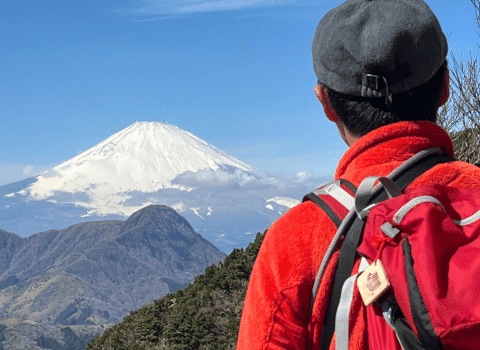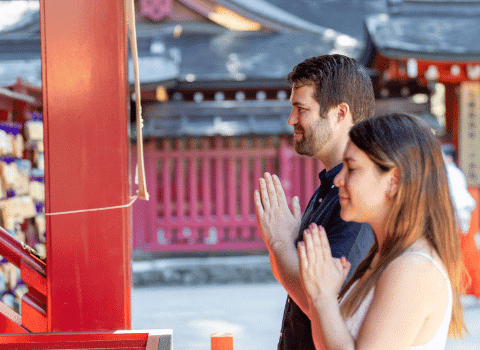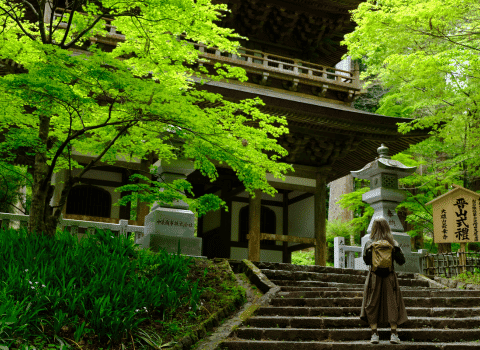
Key Steps for Enjoying Japanese Onsen – Before Entering the Bathing Area:
Remove Shoes: At the entrance to the onsen facility, you’ll typically find shoe lockers or shelves. Remove your outdoor shoes here.
Gender Segregation: Onsens are almost always gender-separated. Look for signs: a red curtain or the kanji 女 (onna) for women, and a blue curtain or 男 (otoko) for men. Double-check before entering to avoid embarrassment!
Changing Room: Inside the changing room, you’ll find lockers or baskets for your clothes and belongings.
Get Completely Naked: This is the most important and often surprising rule for first-timers. Onsens are enjoyed in complete nudity. No swimsuits, underwear, or other clothing are allowed in the bathing area. It might feel awkward at first, but everyone is in the same boat, and it’s part of the cultural experience.
Towels: You’ll typically be given two towels:
- Large Bath Towel: This is for drying yourself completely after your bath, in the changing room. Leave it in your locker.
- Small Hand Towel (Kakeyu Towel): You can bring this into the bathing area. It’s used for washing your body and can be used for modesty while walking around. It should never touch the onsen water. Many people fold it and place it on their head while soaking.

Key Steps for Enjoying Japanese Onsen – In the Bathing Area
Shower Thoroughly (Arai-ba): Before entering the hot spring water, you must wash your entire body thoroughly. There will be an area with individual shower stalls, small stools, and sometimes complimentary soap and shampoo. Sit on the stool and cleanse yourself fully, making sure to rinse off all soap suds. This is crucial for maintaining the cleanliness of the communal bath water.
Enter the Onsen Slowly: The water can be very hot (typically 40-45°C or 104-113°F). Enter slowly to allow your body to adjust. You might want to pour some hot water over your legs and feet first (this is called “kakeyu”).
No Towels in the Water: As mentioned, your small hand towel should never enter the onsen water. Place it on the edge of the bath or fold it and put it on your head. If it accidentally falls in, wring it out outside the bath.
No Hair in the Water: If you have long hair, tie it up so it doesn’t touch the water.
Soak, Don’t Wash: The onsen is for soaking and relaxing, not for washing your body. All washing should be done at the shower stalls.
Maintain Quiet: Onsens are places of relaxation and tranquility. Keep conversations to a low murmur. Avoid loud talking, shouting, or splashing.
No Swimming or Diving: Onsens are not swimming pools. Avoid any vigorous activity like swimming, diving, or splashing.
Hydrate: The hot water can be dehydrating. It’s a good idea to drink plenty of water before and after your bath. Avoid alcohol before or during your onsen visit.
No Phones or Cameras: For privacy and respect, do not bring phones, cameras, or any electronic devices into the bathing area. Photography is strictly prohibited.
Tattoos: Historically, tattoos have been associated with the yakuza (Japanese mafia), and many traditional onsens still prohibit entry to tattooed individuals. However, this is slowly changing, especially in more tourist-heavy areas. If you have tattoos, it’s best to research the specific onsen’s policy beforehand. Some may allow entry if tattoos are small and can be covered with a bandage.
Take Breaks: If the water feels too hot, step out and sit on the edge of the bath to cool down. Don’t stay in for too long, especially if you’re not used to it, to avoid dizziness.

Key Steps for Enjoying Japanese Onsen – After Your Bath
Dry Off Before Re-entering Changing Room: Before stepping back into the changing room, use your small hand towel to wipe off as much excess water from your body as possible. This helps keep the changing room floor dry for others.
Use Large Towel: Once in the changing room, use your large bath towel to dry yourself completely.
Relax: Many onsen facilities have relaxation areas where you can unwind further, often with vending machines for drinks.
By following these etiquette guidelines, you’ll show respect for Japanese culture and ensure a harmonious and enjoyable onsen experience for everyone. Enjoy your soak.
Useful links about onsens in Japan: (Key Steps for Enjoying Japanese Onsen)



